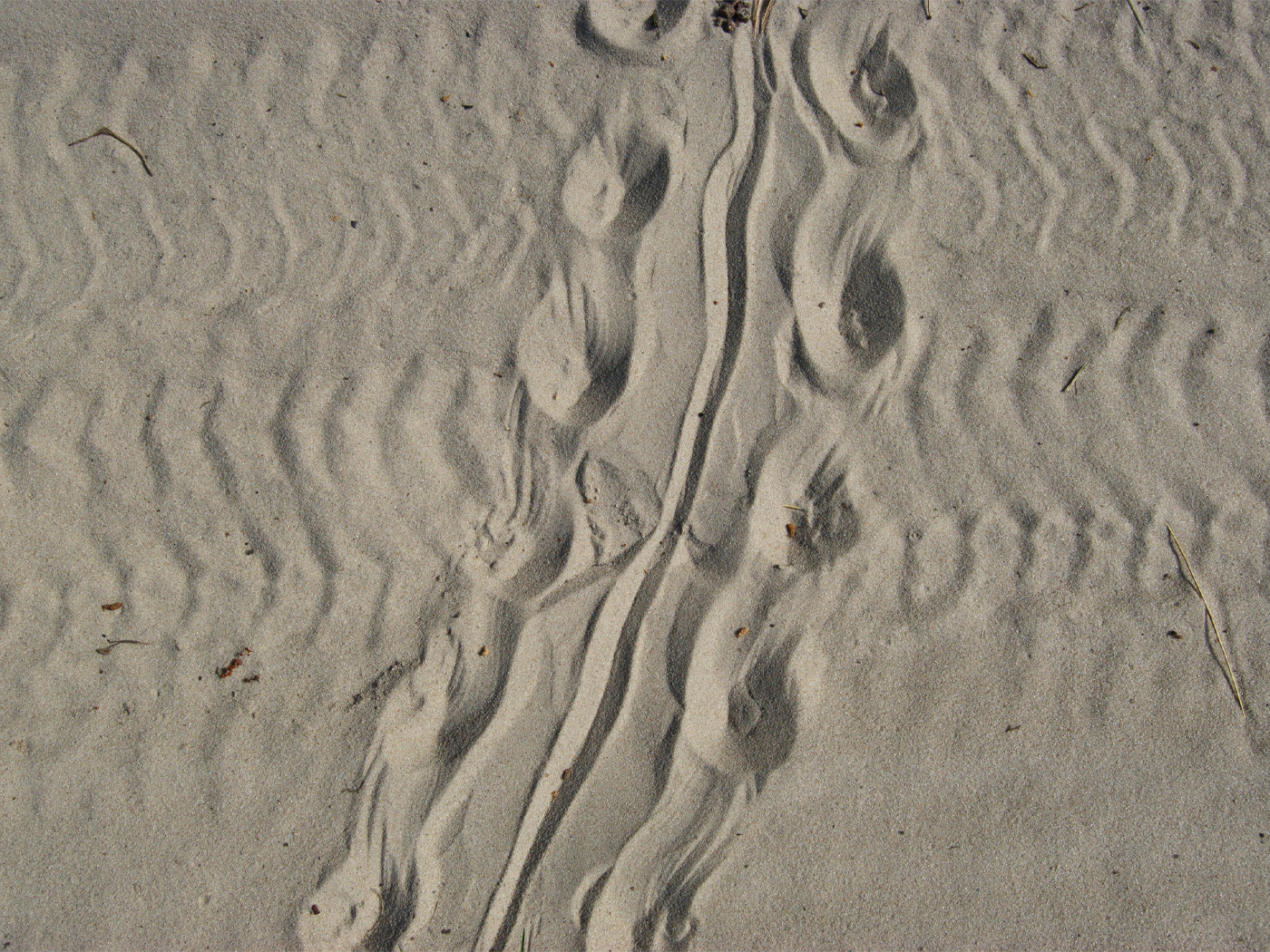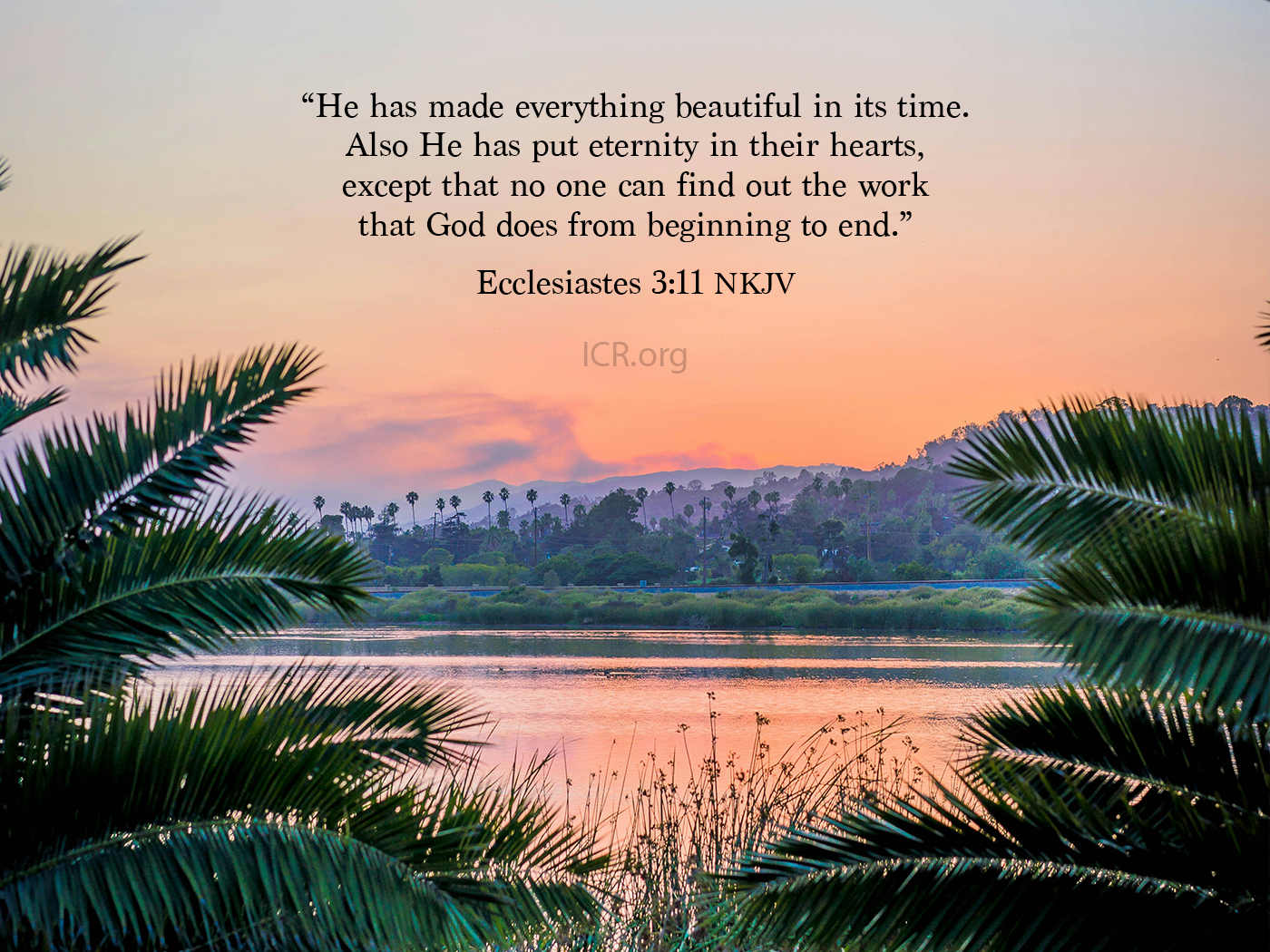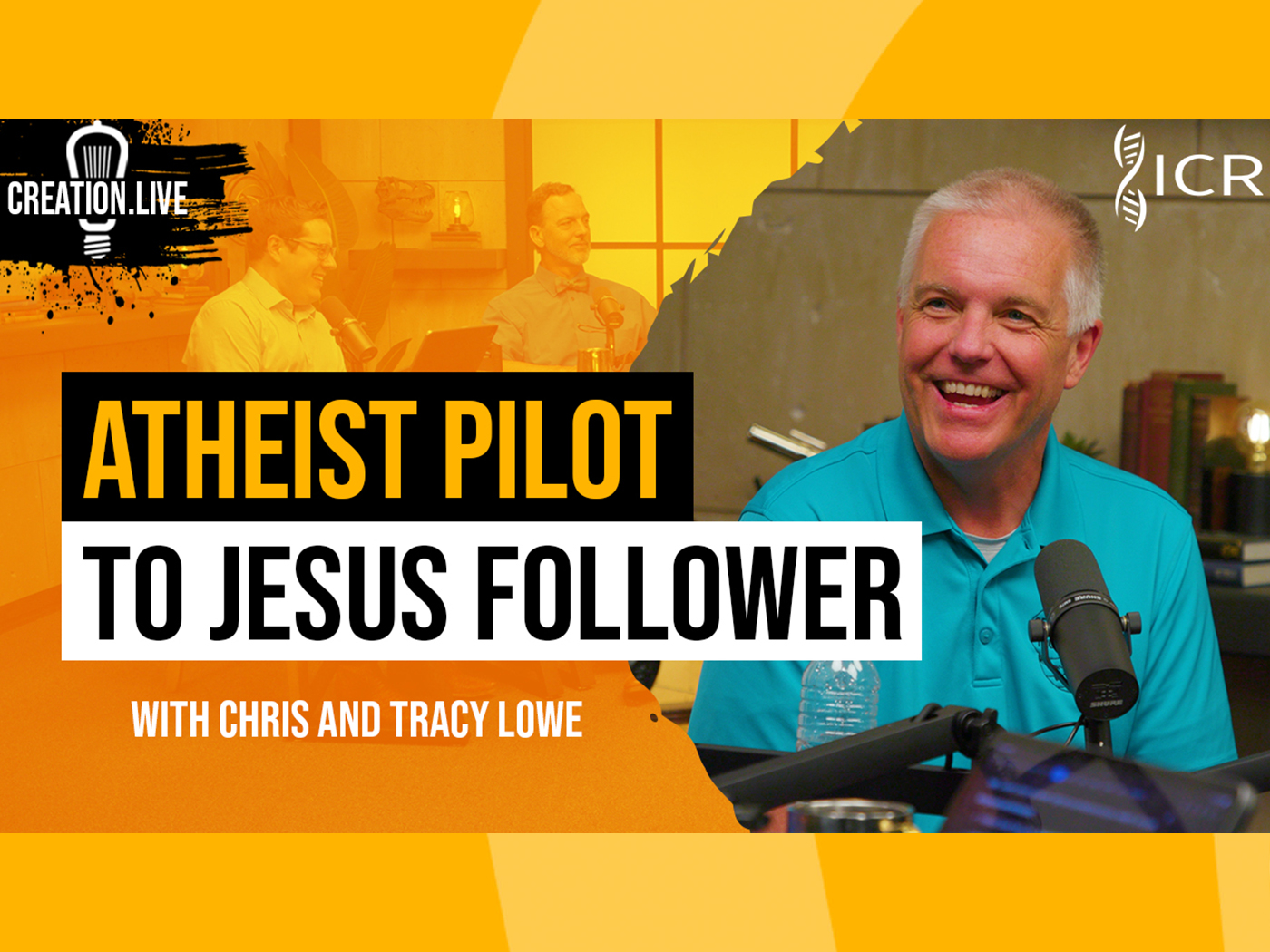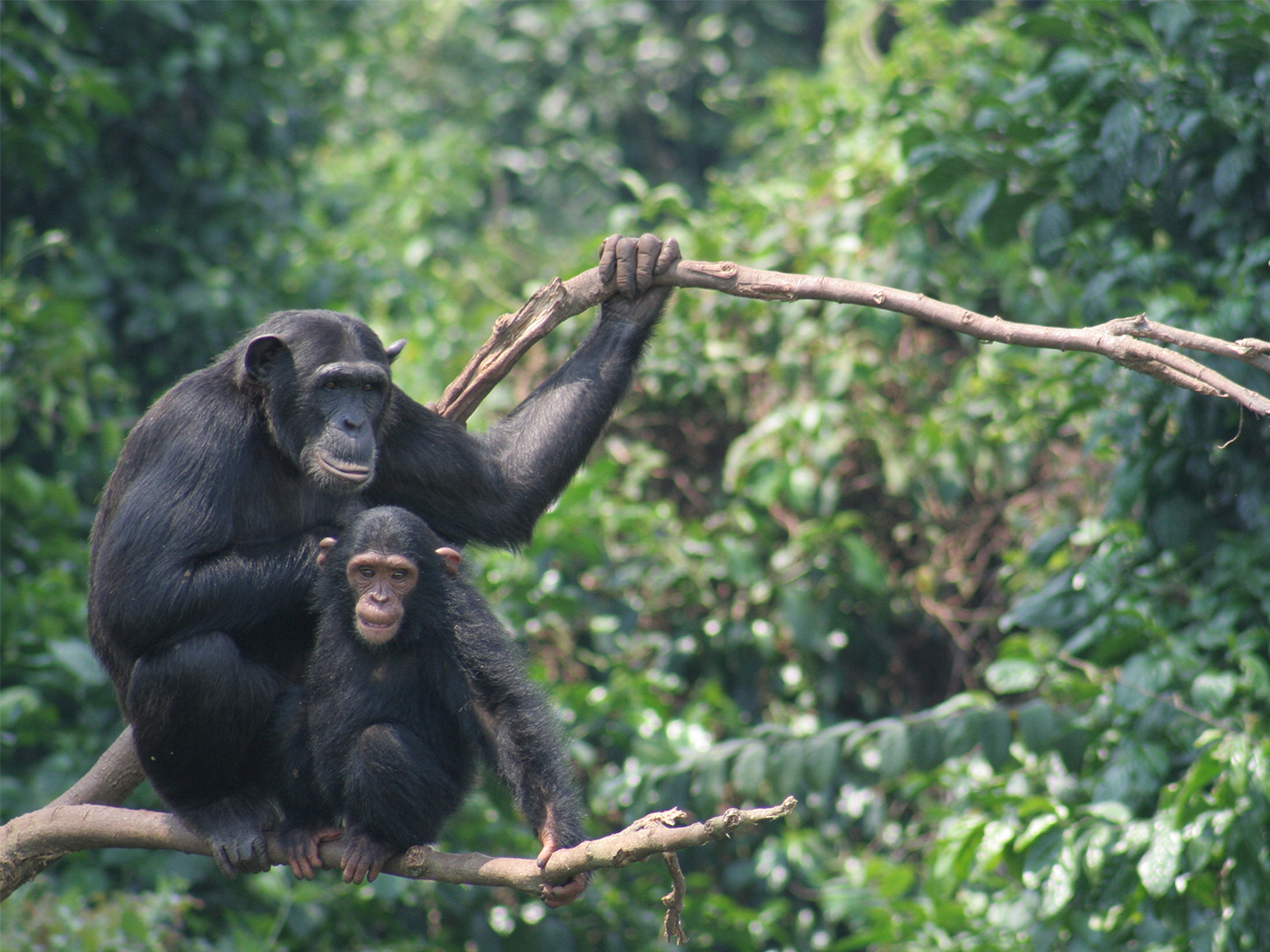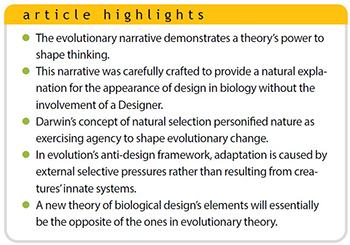 “Based on a true story” is included by movie producers to add authenticity, importance, and a flair of anticipation. So, my account of how I was greatly misled as a youngster is a preemptive response to the question “who cares about theory anyway?” My story accentuates the power of the evolutionary narrative—not factual data—to shape thinking.
“Based on a true story” is included by movie producers to add authenticity, importance, and a flair of anticipation. So, my account of how I was greatly misled as a youngster is a preemptive response to the question “who cares about theory anyway?” My story accentuates the power of the evolutionary narrative—not factual data—to shape thinking.
Three Reasons to Take the Power of Theory Seriously
From a young age I was fascinated by “survival of the fittest.” It just seemed so obvious. I thought it clarified my understanding of the world, and I interpreted things like good and bad, success and failure, and even life and death through that lens.
Later, I learned about genes and their relationship to a creature’s traits. School taught me that random mutations produce various traits in populations that get fractioned out by, you guessed it, survival of the fittest. My mind possessed the major explanation for how life operated. I memorized details. I promoted it to classmates with the zeal of Richard Dawkins. Creatures’ complicated abilities were naturally shaped, I imagined, over unfathomable periods of time by the omnipotent, omnipresent force of natural selection.
But there was another influence. I knew that the theory was accepted by educated people. In my mind, it was absolutely settled science. As far as I knew, it was only rejected by blind, backward religious types. To me, scientists had thoroughly thrashed theologians by demonstrating that “science” is the solitary vehicle to convey truth. Like millions of others, I was seduced. Evolutionary theory fits like a key in the deadbolt of human pride to lock up minds.
My experience is the first reason to take the power of theory seriously. The evolutionary narrative is misleading young people into profoundly ungodly thinking and is wielded to marginalize Christians in the public square.
Along that line, there’s a second reason theory matters. The agenda of all theories is to shape thinking. I was on my way to becoming like Harvard’s evolutionary psychologist Steven Pinker. He brandishes the evolutionary narrative—and its theological implications—to marginalize biblical influence in culture. Christians who might ignore the evolutionary narrative should pay attention to how Pinker unabashedly explains how evolutionary “science” leads society.
In which ways, then, does science illuminate human affairs? Let me start with the most ambitious: the deepest questions about who we are, where we came from, and how we define the meaning and purpose of our lives. This is the traditional territory of religion…[but] the moral worldview of any scientifically literate person—one who is not blinkered by fundamentalism—requires a radical break from religious conceptions of meaning and value.
To begin with, the findings of science entail that the belief systems of all the world’s traditional religions…are factually mistaken. We know, but our ancestors did not, that humans belong to a single species of African primate that developed agriculture, government, and writing late in its history. We know that our species is a tiny twig of a genealogical tree that embraces all living things and that emerged from prebiotic chemicals almost four billion years ago.…
In other words, the worldview that guides the moral and spiritual values of an educated person today is the worldview given to us by science. Though the scientific facts do not by themselves dictate values, they certainly hem in the possibilities. By stripping ecclesiastical authority of its credibility on factual matters, they cast doubt on its claims to certitude in matters of morality.1
Here’s some backstory for the third reason theory matters. Before Darwin put his long selectionist narrative together, he studied the best advocates of intelligent design.2 He read the “intelligent design playbook,” so to speak. Evolutionary theory’s key elements were specifically selected to be a reverse reflection of how a human engineer would purposefully construct something that itself functions purposefully.
Understanding the reasoning for why the evolutionary narrative is built like it is enables design theorists to study the “evolutionary theory playbook.” This will make it easier for them to develop the essential elements of a theory of biological design (TOBD). Why? Because TOBD elements will basically be the opposite of the key components of evolutionary theory—which themselves were developed to oppose vital aspects of intelligent design.
Selectionism: Purposefully Crafted to Counter God’s General Revelation in Nature
As stated above, evolutionary theory was intentionally produced to oppose how biology clearly points to a Creator. Evolutionary authority Jerry Coyne sums up the observation:
If anything is true about nature, it is that plants and animals seem intricately and almost perfectly designed for living their lives....Nature resembles a well-oiled machine, with every species an intricate cog or gear. What does all this seem to imply? A master mechanic, of course.3
Biology, therefore, points to a very big question: Why do creatures possess innumerable features that look like they were purposefully engineered?
When people recognize similar handiwork between living creatures and what human engineers make, they’re seeing a revelation of God declaring His existence to all humanity (Psalm 19:1; Romans 1:18–25). Coyne knows that for millennia people in every culture intuitively thought creatures were crafted by a Creator because they have a highly designed look to them. But Coyne doesn’t believe that revelation. Neither do millions like him—and many of them don’t want others to believe it either.

Most theorists who followed Darwin have intentionally and cleverly continued to refine his anti-design narrative. These folks weren’t led from belief to unbelief by observing any real process that naturally produces incredibly designed organisms without detectable intervention by God. Rather, their initial unbelief in God’s clear self-revelation led them to craft a narrative that conjures up a mystical process that they use as a natural substitute for God in designing creatures.
Prominent evolutionary theorists openly acknowledge the antidesign purpose of the selectionist narrative. For instance, Peter Godfrey-Smith summarizes the ideology of philosopher and cognitive scientist Daniel Dennett of Tufts University:
For Dennett, it is selectionism that prevents us engaging in an erroneous pattern of thinking that is so widespread that traditional religious thinking is only one instance of it. Darwinism enables us to do without “skyhooks,” miraculous interventions that explain the occurrence of design, purpose and meaning.…Selection is seen as a critically important part of a larger intellectual enterprise, the enterprise of developing and defending a secular worldview.…It provides the key to answering Arguments from Design for the existence of various Gods.4
Every assumption of evolutionary theory has been carefully selected to play a part in providing a non-theistic account of why creatures look designed. The narrative is characterized by inherent anti-engineering elements to shape people’s thinking that nature alone is sufficient to produce the appearance of design in creatures. Whether God intervened or not is superfluous.
The big hurdles are: How do you explain apparent purposeful engineering without an engineer? Where did the qualitative difference between a rock and a racoon come from? Darwin is credited with jumping these hurdles. Let’s dig in to what his narrative allegedly accomplished.
Essential Elements for an Anti-design Theory of Biology
Simplicity underlies the success of selectionist thinking. It holds that creatures slowly improve over time because the best organisms ultimately emerge out of deadly struggles to survive. But the real power lies in how that simple narrative seemingly accomplishes what is nigh impossible without an intelligent designer—explaining the origin of the distinctive characteristics of living creatures called agency and purpose.
Agency is the ability to carry out actions as a totally (or nearly) autonomous entity through innate intelligence and volition as an expression of desires, i.e., things one “wants to do.” Agency can be expressed consciously or unconsciously. As far as people can tell, things like rocks, wind, and nature itself can’t exercise agency.
Purpose considers a creature’s many behaviors, parts, systems, etc. that clearly work together to achieve a specific outcome that cannot be attributed to either natural laws or what is termed “chance.” Evolutionists such as Philip Ball, a former editor of Nature, recognize that the current evolutionary narrative doesn’t account for the agency and purpose found in living creatures. A book review of Ball’s How Life Works: A User’s Guide to the New Biology stated:
Ball grapples with the philosophical question of what makes an organism alive. Agency—the ability of an organism to bring about change to itself or its environment to achieve a goal—is [Ball’s] central focus. Such agency, he argues, is attributable to whole organisms, not just to their genomes.…Ball is not alone in calling for a drastic rethink of how scientists discuss biology.…and all argue that agency and purpose are definitive characteristics of life that have been overlooked in conventional, gene-centric views of biology.5
Darwin is venerated for his narrative that explains the origin of creatures’ agency without appealing to any agency at all…especially God’s. Did he really pull that off?
Darwin’s Answer to God’s Agency: Project It onto Nature
For his selectionist narrative, Darwin needed something that doesn’t possess agency but could still somehow act like a true agent. He therefore advanced a very clever, two-pronged approach. First, as we saw in the previous article,6 Darwin supposedly discovered a process that’s creative yet unconscious.7 Scientifically, however, there’s a problem—no one’s ever seen anything unconscious be creative.
Darwin’s solution was to personify nature itself as the creative force. He noticed that pigeon breeders produced diverse varieties by selecting for certain traits. Darwin claimed that nature was analogous to human breeders in that it could also “select for” or “favor” traits. He coined the powerfully misleading term “natural selection” to describe the concept.
This broke from all scientific moorings by projecting onto nature a volitional ability to scrutinize all creatures, everywhere, at all times and unfailingly select the fittest in deadly survival competitions.8 The “natural selector” saves the best traits and over time builds highly engineered organisms custom-fit to diverse environments.
Second, Darwin proposed crediting the cause of an organism’s adaptations to nature and not, as it had been before, to the organism itself. Harvard evolutionary theorist Stephen J. Gould stressed Darwin’s sweeping change in causality:
Darwin’s theory, in strong and revolutionary contrast, presents a first “externalist” account of evolution.…Darwin overturned all previous traditions by thus granting the external environment a causal and controlling role in the direction of evolutionary change.9
This externalistic approach sees organisms as passive “modeling clay”10 being shaped by active environments.11 Selectionist literature frames adaptation such that the environment “directly instructs the organism”12 how to adapt. Externalists imagine a mystical force called selective pressure that is indispensable for shaping their interpretation of adaptation and is perceived to “work on,” “drive,” and “sculpt” a population of organisms. For example, a population of lions is envisioned as a selective pressure that ultimately molds the traits of a neighboring population of gazelles.
In contrast, internalism holds that most biological adaptation happens when highly regulated innate systems purposefully direct modifications of traits toward potentially successful outcomes. But that sounds like a design-based framework. Thus, externalists reject it because for them selective pressures must be both external to and imposed upon organisms.
The personification of nature strips God of His creative agency, and externalism rids creatures of their agency as the causative entity in adaptation. Darwin’s bold, counterintuitive perceptions of personifying nature and pacifying creatures are the way selectionists view living things. Evolutionary biologists didn’t rid biology of a creative agent; they just transferred it to nature.
Darwinism’s Answer to Purpose: “It’s All Random”
Darwin also advanced a very shrewd, two-pronged approach to address the purposeful activities pervading biology. Prong one is the Darwinian head-in-the-sand tactic where evolutionary biologists don’t have to deal with purposeful systems in organisms…because they’re not really there. Darwin tended to ignore purpose by viewing systems rather simplistically. Purposeful systems only appear purposeful, but they really aren’t. Today, evolutionists desperately look for chaos to produce purposeful systems.
Darwin’s disciples have historically treated the concept of purpose itself with contempt. Writing as early as 1887, a pioneer researcher in plant physiology aptly protested, “Concerning one point I should wish to anticipate: viz, the use of the word Purpose, a word which many fanatics of the theory of descent would if possible banish entirely from the language.”13
More recently, professional woe awaits biologists who mention purpose. Darwinists disparage any biologist using even quasi-purposeful language to describe their observations, saying they make biology “sick” and “persist in making (literally) sense of a world that we know to be senseless.”14
It is no longer acceptable to think of biological objects as having any purpose because the overwhelming consensus of scientific opinion is that they were not designed and built by a Creator…with purposes in mind for them.14
Prong number two simply declares that key steps in the adaptation process are random despite the lack of tests that demonstrate this. Why “random”? Because it’s the opposite of purpose. Randomness is at the heart of selectionism.
A classical or Darwinian evolutionary system embodies a basic principle: purposeless genetic variation of reproductive individuals, united by common descent, coupled with…natural selection of those rare individuals that fortuitously express the traits that complement or thwart the contemporary selective pressures.…It’s a process replete with chance.15
How is this anti-design? Though engineers may employ something like a random-number generator within a regulated process, under normal circumstances they reject the blindly muddled “hit and miss” or “trial and error” process envisioned for evolution to accomplish their design process. The evolutionary narrative gets people believing that adaptation happens via random mutations and so on, and then they intuitively sense that this clunky system wasn’t engineered— especially by a wise God. Dennett sums up why attributing causality for adaptation to the environment (externalism) is the opposite of intelligent design.
You’ll never see a spear making a spear maker. You’ll never see a horse shoe making a blacksmith. You’ll never see a pot making a potter. It is always the other way around and this is so obvious that it just seems to stand to reason.…[Intelligent design] captures this deeply intuitive idea that you never get design for free…which Darwin completely impugns with his theory of natural selection. And he shows…not only can you get design from un-designed things, you can even get the evolution of designers from that un-design.16
Pulling It Together: How Theory Guides Interpretations
Upon the bedrock beliefs of purposeless biological activity and environments exercising agency, Gould adds three additional assumptions about genetic variability:
Variation, in short, must be copious, small in extent, and undirected. A full taxonomy of non-Darwinian evolutionary theories may be elaborated by their denial of one or more of these central assumptions.17
These assumptions highlight how the evolutionary narrative is built. They’re not merited by a body of scientific findings but are needed to guide interpretations in line with the narrative’s goal of directing thinking away from the Creator.
Table 1 summarizes how this is accomplished. Narratives guide how observations are interpreted (white section). Let’s say an evolutionist observes a genetic change. Then within the context of externalism (green section) and based on their assumption of undirected genetic change (top gray box), they’ll reflexively interpret the observed genetic change as a random mistake leading to a loss of information (white section). Working through the table highlights how antidesign notions that are baked into evolutionary theory feed the narrative gloss that characterizes what evolutionists “see” in nature and report in papers.
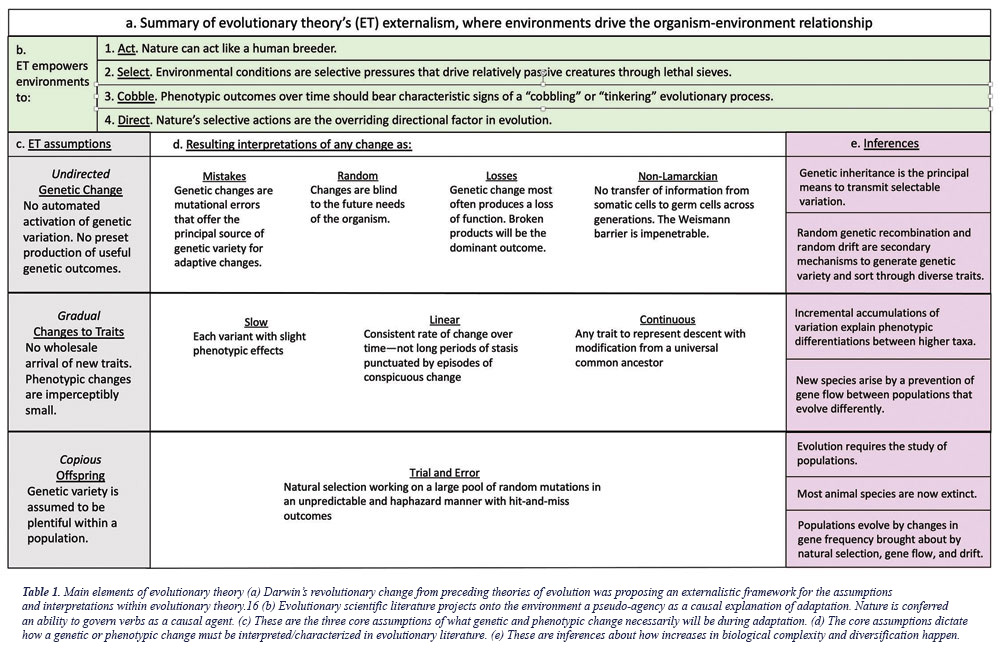
The evolutionary narrative demonstrates the power of theory. It didn’t grow from a series of scientific discoveries that naturally fit together to form a rational guide to understand nature. Instead, it was purposefully manufactured as an anti-design framework to counter God’s revelation in nature. Selectionism—the heart of the evolutionary narrative—is the mental construct framing interpretations in the minds of millions, as it did in mine when I was growing up.
Knowing this background provides a template for building a new theory of biological design that’s opposite to evolution’s anti-design stratagems. The next article will explore this topic.
Click here to read “Why Biology Needs A Theory of Biological Design, Part 1.”
Click here to read “Why Biology Needs A Theory of Biological Design, Part 3.”
Click here to read “Why Biology Needs A Theory of Biological Design, Part 4.”
References
- Pinker, S. Science Is Not Your Enemy: An impassioned plea to neglected novelists, embattled professors, and tenure-less historians. The New Republic. Posted on newrepublic.com August 6, 2013, accessed February 20, 2024. Emphasis added.
- Gould, S. J. 2002. The Structure of Evolutionary Theory. Cambridge, MA: Harvard University Press, 116–118.
- Coyne, J. 2009. Why Evolution Is True. New York, NY: Viking, 1.
- Godfrey-Smith, P. 2001. Chapter 11: Three Kinds of Adaptationism. In Adaptationism and Optimality. S. H. Orzack and E. Sober, eds. Cambridge, UK: Cambridge University Press, 349–350.
- Noble, D. 2024. It’s time to admit that genes are not the blueprint for life. Nature. 626 (7998): 254–255. DOI: 10.1038/d41586-024-00327-x.
- Guliuzza, R. J. 2024. Why Biology Needs a Theory of Biological Design—Part 1. Acts & Facts. 53 (2): 4–7.
- Ayala, F. J. 2007. Darwin’s greatest discovery: Design without designer. Proceedings of the National Academy of Sciences. 104: 8567–8573.
- Natural Selection Part 1: A Darwinian Deception. Creation.Live Podcast. Institute for Creation Research. Posted on youtube.com June 24, 2022.
- Gould, The Structure of Evolutionary Theory, 161–162. Emphasis added.
- Kirschner, M. W. and J. C. Gerhart. 2005. The Plausibility of Life: Resolving Darwin’s Dilemma. New Haven, CT: Yale University Press, 3.
- Guliuzza, R. J. 2017. Engineered Adaptability: Adaptability via Nature or Design? What Evolutionists Say. Acts & Facts. 46 (9): 17–19.
- Gilbert, S. F. and D. Epel. 2009. Ecological Developmental Biology: Integrating Epigenetics, Medicine, and Evolution. Sunderland, MA: Sinauer Associates, 370 and 407.
- Von Sachs, J. 1887. Lectures on the physiology of plants. Oxford, UK: Clarendon Press, 10.
- Hanke, D. 2004. Teleology: The explanation that bedevils biology. In Explanations: Styles of Explanation in Science. J. Cornwell, ed. Oxford and New York: Oxford University Press, 143–155.
- Greaves, M. and C. C. Maley. 2012. Clonal Evolution in Cancer. Nature. 481: 306–313.
- SPIEGEL Interview with Evolution Philosopher Daniel Dennett: Darwinism Completely Refutes Intelligent Design. Der Spiegel. Posted on spiegel.de December 26, 2005, accessed March 3, 2024.
- Gould, The Structure of Evolutionary Theory, 141–145.
* Dr. Guliuzza is president of the Institute for Creation Research. He earned his Doctor of Medicine from the University of Minnesota, his Master of Public Health from Harvard University, and served in the U.S. Air Force as 28th Bomb Wing Flight Surgeon and Chief of Aerospace Medicine. Dr. Guliuzza is also a registered professional engineer and holds a B.A. in theology from Moody Bible Institute.




